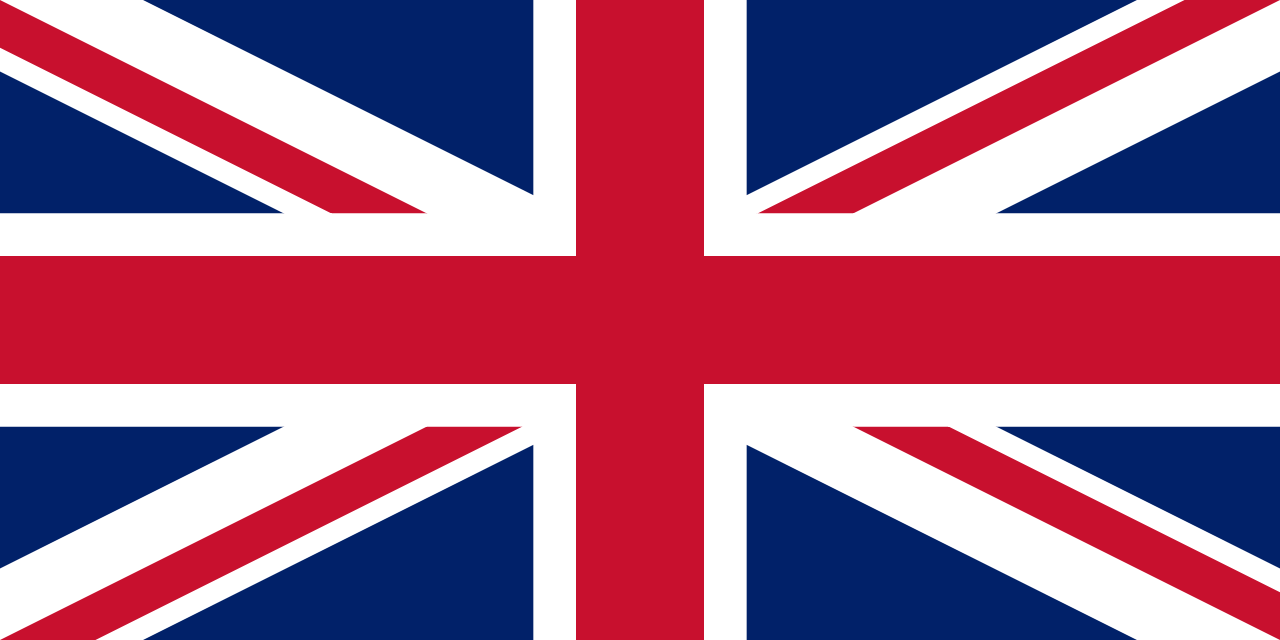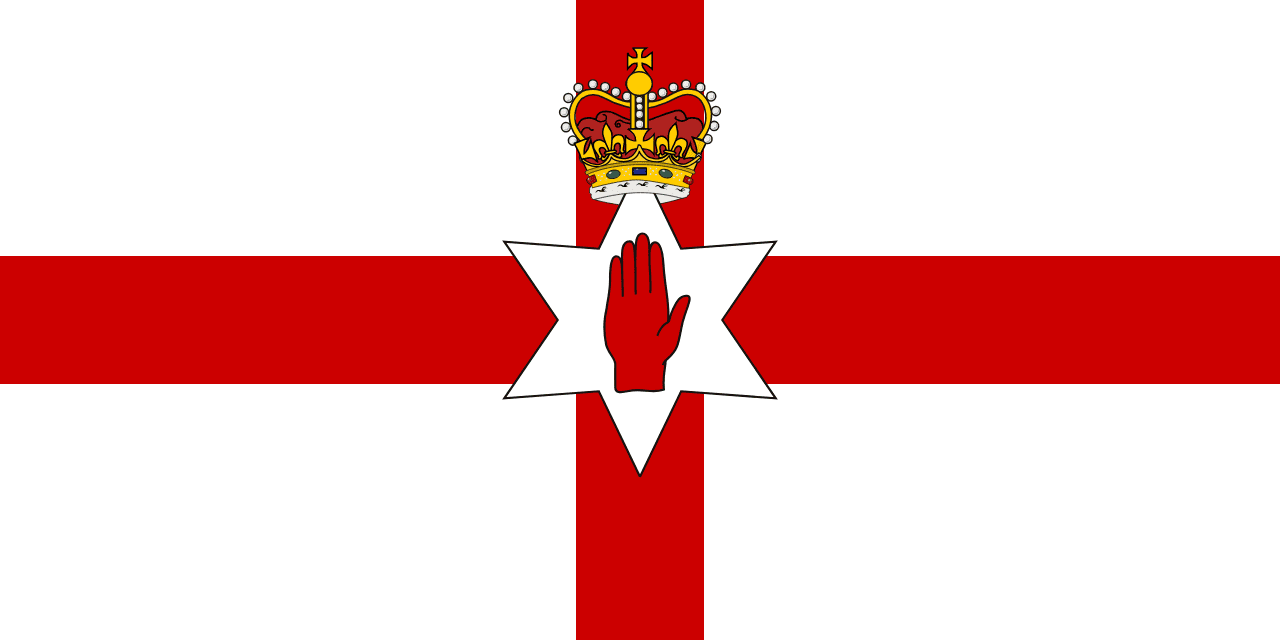United Kingdom Flag Meaning
The Union Jack combines the crosses of Saint George (England), Saint Andrew (Scotland), and Saint Patrick (Ireland) on a blue field, representing the political union of England, Scotland, and Ireland under one crown, though Wales is not directly represented in the flag design.
- Continent
- Europe
- Adopted
- 1801
- Ratio
- 1:2
- Colors
- blue, white, red
- Designer
- Unknown

Symbolism
Saint George's Cross (Red): Represents England and its patron saint, displayed as a red cross on white background, symbolizing the largest constituent country and the center of political power within the United Kingdom.
Saint Andrew's Cross (White): Represents Scotland and its patron saint, displayed as a white diagonal cross on blue background, symbolizing the northern kingdom that joined with England in 1707 to form Great Britain.
Saint Patrick's Cross (Red Diagonal): Represents Ireland and its patron saint, displayed as a red diagonal cross, symbolizing Ireland's incorporation into the United Kingdom in 1801, though most of Ireland later became independent.
Blue Field: Represents the blue from Scotland's flag, serving as the background that unites all the crosses and symbolizing the maritime heritage that made Britain a global naval power.
Absence of Wales: Wales is not directly represented because it was already considered part of England when the flag was designed, having been conquered and annexed much earlier than Scotland or Ireland.
History
- Pre-Roman Era: Celtic tribes inhabited the British Isles, developing distinct cultures in what would become England, Scotland, Wales, and Ireland, with complex relationships and occasional unity against external threats.
- 43-410 AD: Roman conquest brought Latin culture, Christianity, and urbanization to England and Wales, while Scotland and Ireland remained largely independent, maintaining Celtic traditions and languages.
- 5th-11th Century: Anglo-Saxon kingdoms emerged in England after Roman withdrawal, while distinct Scottish, Welsh, and Irish kingdoms developed, with occasional attempts at unification under powerful rulers.
- 1066-1603: Norman conquest unified England under centralized monarchy, while gradual expansion brought English control over Wales (1282) and attempts to control Scotland and Ireland through warfare and marriage alliances.
- 1603: The Union of Crowns brought Scottish King James VI to the English throne as James I, uniting the crowns but maintaining separate kingdoms with distinct laws and institutions.
- May 1, 1707: The Act of Union merged the kingdoms of England and Scotland into the Kingdom of Great Britain, creating a single parliament in Westminster while preserving Scottish legal and religious systems.
- January 1, 1801: The Act of Union with Ireland created the United Kingdom of Great Britain and Ireland, adopting the current Union Jack design and bringing Irish representatives to Westminster.
- 1707-1914: The British Empire expanded to become the largest empire in history, covering a quarter of the world's land area and population, while the Industrial Revolution transformed British society.
- 1914-1945: Two world wars devastated Europe but ultimately confirmed British leadership of the Allied victory, though the empire began to decline and independence movements gained strength.
- 1921: The partition of Ireland created Northern Ireland (remaining in the UK) and the Irish Free State (later Republic of Ireland), fundamentally changing the character of the union.
- 1945-1997: Decolonization dismantled the British Empire while the welfare state was established, and the UK joined the European Economic Community (1973), integrating into European institutions.
- 1997-Present: Devolution granted significant autonomy to Scotland, Wales, and Northern Ireland, while Brexit (2016-2020) ended EU membership and created new constitutional tensions within the union.
Trivia
- The United Kingdom consists of four constituent countries - England, Scotland, Wales, and Northern Ireland - each with distinct cultures, legal systems, and varying degrees of autonomy.
- The flag represents the country that had the world's largest empire at its peak, covering about 25% of the world's land area and ruling over 400 million people by the early 20th century.
- English is the de facto official language, but Welsh is co-official in Wales, Scottish Gaelic is recognized in Scotland, and Ulster Scots and Irish are recognized in Northern Ireland.
- The UK is the birthplace of the Industrial Revolution, parliamentary democracy, and many scientific discoveries including evolution (Darwin), gravity (Newton), and penicillin (Fleming).
- London is one of the world's leading financial centers alongside New York, while the City of London operates as a largely autonomous financial district with medieval privileges.
- The flag flies over a country that gave the world Shakespeare, The Beatles, Harry Potter, and countless other cultural contributions that have shaped global entertainment and literature.
- The UK has no written constitution but operates under an uncodified system based on statutes, common law, and constitutional conventions developed over centuries.
- Traditional British culture includes afternoon tea, pub culture, cricket, and football (soccer), though the country is increasingly multicultural due to immigration from former colonies.
- The British monarchy is a constitutional system where the sovereign serves as head of state while elected politicians hold real power, with elaborate ceremonies maintaining historical traditions.
- Scotland has its own legal system, education system, and established church (Presbyterian), while England and Wales share legal systems and the established church is Anglican.
- The UK was a founding member of NATO and the UN Security Council, and maintains the world's fifth-largest defense budget despite its relatively small size.
- Brexit, completed in 2020, ended 47 years of EU membership and created new trade arrangements, immigration policies, and constitutional questions about the future of the union.
- Traditional foods include fish and chips, roast beef and Yorkshire pudding, haggis (Scotland), and afternoon tea with scones, reflecting regional variations and class distinctions.
- The flag represents a country facing significant constitutional challenges, with Scottish independence movements, Northern Ireland border issues, and questions about English representation creating ongoing tensions.
- Despite its imperial past, the UK maintains the Commonwealth of Nations, a voluntary association of 54 countries that provides ongoing cultural and economic connections with former colonies.
Related Countries

Scotland
Europe
The Saltire - white diagonal cross of Saint Andrew on azure blue field, one of the world's oldest national flags.

Northern Ireland
Europe
The Ulster Banner - featuring the Red Hand of Ulster on a white field with the Union Jack canton and crown, served as Northern Ireland's official flag from 1953-1972 and remains in unofficial use today.

Wales
Europe
Y Ddraig Goch - the red dragon passant on green and white horizontal field, representing Welsh heritage and Celtic identity.

Ireland
Europe
Three equal vertical stripes of green, white, and orange, representing the hope for peace between the Catholic and Protestant communities of Ireland, with the tricolor symbolizing unity and the aspiration for a harmonious Irish nation.

Netherlands
Europe
A horizontal tricolor of red, white, and blue, the oldest tricolor still in use today. It originated in the 16th century during the Dutch Revolt against Spain.

Belgium
Europe
Three vertical stripes of black, yellow, and red derived from the coat of arms of the Duchy of Brabant, adopted during Belgium's independence revolution and representing the nation's determination, generosity, and sacrifice.